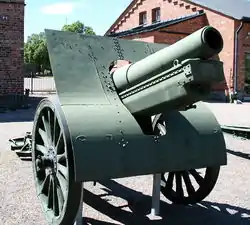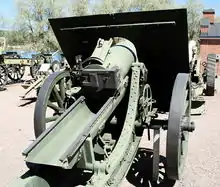152 mm howitzer M1909/30
152 mm howitzer M1909/30 (Russian: 152-мм гаубица обр. 1909/30 гг.) was a Soviet 152.4 mm (6 inch) howitzer, a modernization of the 152 mm howitzer M1909, initially designed by Schneider. It was the most numerous 152 mm howitzer employed by Red Army in World War II.
| 152 mm howitzer M1909/30 | |
|---|---|
 M1909/30 in Hämeenlinna Artillery Museum, Finland | |
| Type | field howitzer |
| Place of origin | USSR |
| Production history | |
| Manufacturer | Perm plant |
| Produced | 1931–1941 |
| No. built | 2,550–2,611 |
| Specifications | |
| Mass | combat: 2,810 kg (6,195 lbs) travel: 3,270 kg (7,209 lbs) |
| Length | 5.84 m (19 ft 2 in) |
| Barrel length | overall: 2.16 m (7 ft 1 in) L/14 bore: 1.9 m (6 ft 3 in) L/13.1 |
| Width | 1.89 m (6 ft 2 in) |
| Height | 1.92 m (6 ft 4 in) |
| Crew | 8 |
| Shell | 152 x 239mm R |
| Caliber | 152.4 mm (6 in) |
| Breech | interrupted screw |
| Recoil | Hydro-pneumatic |
| Carriage | Box trail |
| Elevation | 0° to 41° |
| Traverse | 2°50’ |
| Rate of fire | 5-6 rounds per minute |
| Muzzle velocity | 344 m/s (1,129 ft/s) |
| Maximum firing range | 8,850 m (9,678 yds) |
Development and production history
From the late 1920s, the RKKA sought to upgrade its World War I-era artillery pieces. One of the modernized weapons was the 152 mm howitzer M1909, initially designed by the French arms manufacturer Schneider. After several experiments it was determined that the muzzle velocity of the piece could be increased to about 395 m/s (further increase could result in damage to the carriage). In 1930 at the Bolshevik Plant, the gun was experimentally fitted with a muzzle brake.
In 1930-1931, the Perm plant developed a modernization project. Initially, the only element of the project was lengthening the chamber to 340 mm (upgraded barrels received a mark "lengthened chamber"). In late production pieces minor changes in breechblock, cradle and elevation mechanism were introduced. Some pieces also had their wooden wheels replaced by steel ones with rubber tires. The modernized weapon was officially adopted as 152-mm howitzer model 1909/30.
The M1909/30 was a typical short-barrel howitzer, intended mostly for shooting with elevations from +20° to +41°, using separately loaded ammunition. The gun had interrupted screw breechblock; hydraulic recoil buffer and hydro-pneumatic recuperator were both mounted under the barrel. The carriage was of single trail type with limited traverse and, typically, unsprung wooden wheels (some pieces produced from 1937 had metal wheels with solid rubber tires). With the gun was issued limber, which had either wooden or metal wheels.
From 1931 to 1941 the Perm plant delivered 2,188 pieces.
| Production of M1909/30, pcs.[1] | ||||||||||||
| Year | 1931 | 1932 | 1933 | 1934 | 1935 | 1936 | 1937 | 1938 | 1939 | 1940 | 1941 | Total |
| Produced, pcs. | 158 | 210 | 260 | 54 | 2 | 0 | 99 | 480 | 620 | 295 | 10 | 2,188 |
Organization and employment

Under the organization of 1939, each rifle division had a howitzer regiment with a 152-mm howitzers battalion (12 pieces). In July 1941 these regiment were cancelled. Same fate befell 152-mm howitzers battalions of motorized and armored divisions.
Estonia used 4 M1909s on 2 railway artillery platforms in the Estonian Armored Train Regiment from 1934-1941.[2] The Estonian artillery pieces would later be captured and used by the USSR in the Second World War after the USSR invaded and occupied the Baltic States.[3]
Corps artillery units didn't employ 152-mm howitzers early in the war (they did use howitzer-guns ML-20); but from late 1943 the recreated corps artillery included a regiment consisted of five batteries (totaling 20 pieces), equipped, along with other types, with 152-mm howitzers. By 1 June 1944, there were 192 such pieces in corps artillery.
Reserve of the Main Command included howitzer regiments (48 pieces) and heavy howitzer brigades (32 pieces), sometimes organized into artillery divisions.
The howitzer was used by the RKKA in the Battle of Khalkhin Gol[4] and in the Winter War. At the outbreak of the German-Soviet War the M1909/30 was still the most numerous 152-mm howitzer in Soviet service. On 1 June 1941, the RKKA possessed about 2,500 pieces,[5] about twice as much as the newer M-10s, which were soon removed from production. Although from 1943 the M1909/30 was again being gradually replaced, this time by D-1, it was still in service by the end of the war.
A number of guns of this type fell into the hands of Wehrmacht in 1941-42; these were adopted as 15,2 cm sFH 445(r). Germans also produced ammunition for these guns.[6] Most of the pieces were assigned to coastal artillery.
Finnish Army captured 14 pieces during the Winter War, and 85 more early in the Continuation War. The guns were actively used in combat. As a training weapon, the M1909/30 remained in Finnish service until the 1980s.
Summary

2 - fragmentation shell O-530,
3 - HEAC (anti-concrete) shell G-530.
The M1909/30 was a relatively minor upgrade of a World War I-era howitzer, which did not address the main flaws of the latter, namely:
- Limited towing speed due to unsprung wheels
- Limited elevation and very small traverse
A short barrel meant short range, less than that of its main adversaries, such as the German 15 cm sFH 18 (8.8 km vs 13.3 km). Low muzzle velocity and small traverse also made the gun helpless against enemy armor.
On the other side, the M1909/30 was rugged and reliable. It was also relatively light and could be set up for combat in 30–40 seconds. Thanks to it, the howitzer was well liked in the RKKA.
In 1930 the Soviet Union still was not ready for development and mass production of modern artillery, so the upgrade of old guns was a reasonable decision.
Ammunition
When set to fragmentation action, the OF-530 produced fragments which covered an area 70 m wide and 30 m deep. When set to HE action, the exploding shell produced a crater about 3.5 m in diameter and about 1.2 m deep.
| Available ammunition[7] | |||||
| Type | Model | Weight | HE weight | Muzzle velocity, m/s | Range, m |
| Anti-concrete shells | |||||
| Anti-concrete shell | G-530 / G-530Sh | 40.0 kg (88 lb) | 5.1 kg (11 lb) | ||
| High explosive and fragmentation shells | |||||
| HE-Fragmentation, steel | OF-530 | 40.0 kg (88 lb) | 5.47–6.86 kg (12–15 lb) | ||
| HE-Fragmentation, steely iron | OF-530A | 40.0 kg (88 lb) | 5.66 kg (12 lb) | ||
| HE, old | F-533 | 40.41 kg (89 lb) | 8.0 kg (18 lb) | ||
| HE, old | F-533K | 40.68 kg (90 lb) | 7.3 kg (16 lb) | ||
| HE, old | F-533N | 41.0 kg (90 lb) | 7.3 kg (16 lb) | ||
| HE, old | F-533U | 40.8 kg (90 lb) | 8.8 kg (19 lb) | ||
| HE, steely iron, old French | F-534F | 41.1 kg (91 lb) | 3.9 kg (9 lb) | ||
| HE for 152-mm mortar model 1931 | F-521 | 41.7 kg (92 lb) | 7.7 kg (17 lb) | ||
| HE, British, for Vickers 152-mm howitzer | F-531 | 44.91 kg (99 lb) | 5.7 kg (13 lb) | ||
| Shrapnel shells | |||||
| Shrapnel with 45 sec. tube | Sh-501 | 41.16–41.83 kg (91–92 lb) | 0.5 (680—690 bullets) | ||
| Shrapnel with Т-6 tube | Sh-501T | 41.16 kg (91 lb) | 0.5 (680—690 bullets) | ||
| Illumination shells | |||||
| Illumination, 40 sec. | S 1 | 40.2 kg (89 lb) | |||
| Chemical shells | |||||
| Fragmentation-chemical gun shell | OH-530 | 38.8 kg (86 lb) | |||
| Chemical howitzer shell | HN-530 | 39.1 kg (86 lb) | |||
Surviving pieces
The gun can be seen:
- In Museum of Artillery and Engineering Forces, Saint Petersburg, Russia.
- In Artillery Museum in Hämeenlinna, Finland.
- The Cannons at Torp Museum in Ingå, Finland
Notes
- Shirokorad A. B. - Encyclopedia of the Soviet Artillery.
- Salo, U (2005). Eesti kaitseväe valmisolek sõjaks ja vastupanuvõimalused 1939. aastal (PDF) (in Estonian). Tartu: University of Tartu.
- Allandi, Harri (2007). Tapal paiknenud soomusrongirügement sõnas ja pildis 1923–1940 (in Estonian). Tapa: Trükk Pakett AS.
- Kolomiets M. - The Battle of River Khalkhin-Gol.
- 2,432 according to Isaev A. - Antisuvorov, 2,607 according to http://www.soldat.ru/doc/mobilization/mob/table17.html, 2,611 according to Ivanov A. - Artillery of the USSR in Second World War.
- Shirokorad A. B. - The God of War of the Third Reich.
- Shirokorad A. B. - Encyclopedia of the Soviet Artillery.
References
- Shunkov V. N. - The Weapons of the Red Army, Mn. Harvest, 1999 (Шунков В. Н. - Оружие Красной Армии. — Мн.: Харвест, 1999.) ISBN 985-433-469-4
- Shirokorad A. B. - Encyclopedia of the Soviet Artillery - Mn. Harvest, 2000 (Широкорад А. Б. - Энциклопедия отечественной артиллерии. — Мн.: Харвест, 2000., ISBN 985-433-703-0)
- Shirokorad A. B. - The God of War of the Third Reich - M. AST, 2002 (Широкорад А. Б. - Бог войны Третьего рейха. — М.,ООО Издательство АСТ, 2002., ISBN 5-17-015302-3)
- Ivanov A. - Artillery of the USSR in Second World War - SPb Neva, 2003 (Иванов А. - Артиллерия СССР во Второй Мировой войне. — СПб., Издательский дом Нева, 2003., ISBN 5-7654-2731-6)
- Isaev A. - Antisuvorov - 2004 (Исаев A. - Антисуворов - 2004)
- Kolomiets M. - The Battle of River Khalkhin-Gol - "Frontovaya Illustratsiya" magazine, no. 2, 2002 (М.Коломиец. - Бои у реки Халхин-Гол. - журнал «Фронтовая иллюстрация», №2, 2002)
- http://www.soldat.ru/doc/mobilization/mob/table17.html
- Heavy howitzers of the Finnish Army 1918-45 at Jaegerplatoon.net
